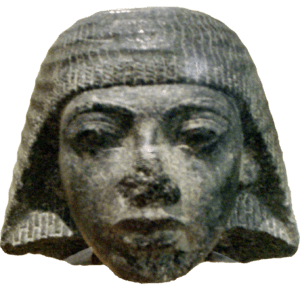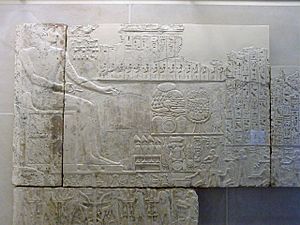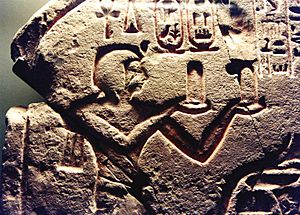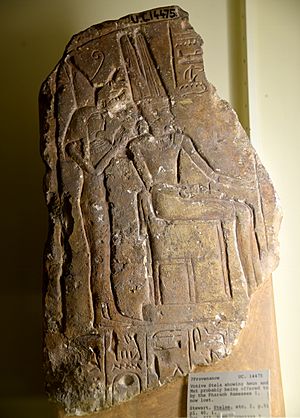Ramesses I facts for kids
Quick facts for kids Ramesses I |
|
|---|---|
| Menophres | |

Stone head carving of Paramessu (Ramesses I), originally part of a statue depicting him as a scribe; on display at the Museum of Fine Arts, Boston
|
|
| Pharaoh | |
| Reign | 1292–1290 BC or 1295–1294 BC (19th Dynasty) |
| Predecessor | Horemheb |
| Successor | Seti I |
| Consort | Sitre |
| Children | Seti I |
| Father | Seti |
| Died | 1290 BC |
| Burial | KV16 |
Ramesses I was an important pharaoh who started the 19th Dynasty in ancient Egypt. His rule was short, lasting only about two years, from around 1292 to 1290 BC. Even though his reign was brief, he was key in connecting the rule of Horemheb (who brought stability to Egypt) with the strong pharaohs of his own family. His son, Seti I, and grandson, Ramesses II, became very powerful leaders, making Egypt a great empire.
Contents
Ramesses I's Early Life
Ramesses I was not born into the royal family. His original name was Pa-ra-mes-su. He came from a noble military family in the Nile Delta region. His father, Seti, was a troop commander.
Ramesses I's family had high status. His uncle, Khaemwaset, was an army officer. Khaemwaset married Tamwadjesy, who was in charge of the Harem of Amun. She was also related to Huy, an important official in Kush.
Ramesses I gained favor with Horemheb, the last pharaoh of the Eighteenth Dynasty. Horemheb made Ramesses his vizier, which was like a prime minister. Ramesses also served as the High Priest of Set. This role was important in bringing back the old religion after the changes made by Akhenaten.
How Ramesses I Became Pharaoh
Horemheb himself was not from the royal family. He rose through the army ranks to become a royal advisor. He served pharaohs like Tutankhamun and Ay before becoming pharaoh himself. Horemheb had no children who survived him.
Because of this, Horemheb chose Ramesses to be his heir. Ramesses I was a skilled administrator. He also had a son, Seti I, and a grandson, the future Ramesses II. This meant there would be a clear line of succession, avoiding problems after Horemheb's death.
When Ramesses became pharaoh, he took a royal name, or prenomen. This name was Menpehtyre, meaning "Established by the strength of Ra". However, he is better known by his personal name, or nomen, which is Ramesses. This name means 'Ra bore him'.
Ramesses I was already an old man when he became king. He quickly named his son, Seti I, as the Crown Prince and his chosen successor. Seti was put in charge of military actions, especially trying to get back some of Egypt's lands in Syria. Ramesses I focused on matters within Egypt. He finished the second pylon at Karnak Temple, which Horemheb had started.
Ramesses I's Death and Burial

Ramesses I ruled for a very short time. There are not many monuments from his reign. He did not have much time to build large structures. He was quickly buried in a small, unfinished tomb. The ancient Egyptian priest Manetho said he ruled for 16 months. However, records show he ruled for at least 17 months. His highest known date is from his second year as pharaoh.
Ramesses I died about five months later, in June 1290 BC. His son, Seti I, took power soon after. One of Ramesses I's known actions was to provide supplies for the temple of Ptah in the fortress of Buhen in Nubia. He also ordered a chapel and a temple to be built at Abydos, which his son finished.
The aged Ramesses was buried in the Valley of the Kings. His tomb, called KV16, was found by Giovanni Belzoni in 1817. It is small and looks like it was finished very quickly. The walls were plastered and painted to show the king with his gods. His red granite sarcophagus was also painted instead of carved.
Seti I, his son, later built a small chapel at Abydos to honor his father. This chapel had beautiful reliefs. In 1911, John Pierpont Morgan gave some of these reliefs to the Metropolitan Museum of Art in New York.
Rediscovering Ramesses I's Mummy
A mummy believed to be Ramesses I was stolen from Egypt. It was displayed in a private museum in Canada for many years. Scientists used CT scans, X-rays, and other tests to identify it. They believe it is Ramesses I because of family resemblances and how the mummy's arms were crossed. This arm position was only used for Egyptian royalty until 600 BC.
The Abu-Rassul family, who were grave robbers, stole the mummy. It was brought to North America around 1860 by Dr. James Douglas. The mummy was then kept at the Niagara Museum and Daredevil Hall of Fame in Niagara Falls, Ontario, Canada. It stayed there for over 130 years, its identity unknown.
In 1999, a Canadian businessman named William Jamieson bought the museum's contents. With help from an Egyptologist, he realized the artifacts were very valuable. Jamieson sold the Egyptian items, including the mummies, to the Michael C. Carlos Museum at Emory University in Atlanta, Georgia.
The mummy was returned to Egypt on October 24, 2003. It received full official honors. Today, it is on display at the Luxor Museum.
See also
 In Spanish: Ramsés I para niños
In Spanish: Ramsés I para niños



